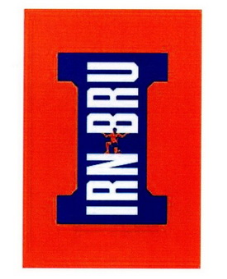Abstract
We, Kangxin Partners, P.C., on behalf of client, A.G.BARR P.L.C., filed an opposition action against the trademark  under application No. 54575437 in Class 32 (thereafter referred as “opposed mark”) and the National Intellectual Property Administration, PRC (“CNIPA”) subsequently examined the case and decided to reject the opposed mark for registration.
under application No. 54575437 in Class 32 (thereafter referred as “opposed mark”) and the National Intellectual Property Administration, PRC (“CNIPA”) subsequently examined the case and decided to reject the opposed mark for registration.
Background
The client’s brand, IRN-BRU is a Scottish carbonated soft drink, often described as "Scotland's other national drink" (after whisky). Introduced in 1901, the drink is produced in Westfield, Cumbernauld, North Lanarkshire, by A.G.BARR P.L.C.. As well as being sold throughout the United Kingdom, IRN-BRU is also available throughout the world. IRN-BRU has been the top-selling soft drink in Scotland for over a century, competing directly with global brands such as Coca-Cola. Upon finding the opposed mark, the client believed that it was similar to their prior registered marks, so that they entrusted us to file an opposition action against it.
The comparison of the marks is as below:

Summary of the case
In this opposition case, we mainly argued that:
1) The opposed mark and the client’s cited marks constitute "similar mark over similar goods”, in violation of Article 30 of China Trademark Law.
2) Given the high reputation of the client and their marks, use and registration of the opposed mark may easily lead to confusion and misunderstanding amongst relevant consumers regarding the resource and quality of the goods.
The CNIPA made an opposition decision on September 18, 2022: the opposed mark is similar to the cited marks in terms of letter composition and pronunciation, and both parties’ goods are same or similar with respect to functions, usage and sales channels. Thus, as per Article 30 of China Trademark Law, the opposed mark should not be approved for registration given it constitutes a "similar mark over similar goods" with the cited marks.
Key Point of the Case
The key point of this case is that 1) the opposed mark is a “similar mark” with the cited marks, and 2) The goods of the opposed mark are similar to those of the cited marks.
With regard to Point 1, we argued from below aspects: 1) Even though the opposed mark “ ”consists of a single word comprising of four letters, the cited marks,
”consists of a single word comprising of four letters, the cited marks,  and
and  are made up of two words, “IRN” and “BRU” comprising of six letters. Of these six letters, the first letter “I” and the last three letters “BRU” are fully contained within the opposed mark, “IBRU”. 2) We presented prior similar precedents to prove that the CNIPA should also apply same criteria in this opposition case. 3) We further provided the media reports regarding the client’s cited marks as evidence to prove the high reputation of the client’s marks amongst relevant public. All of the aforesaid facts and evidence can prove that coexistence of the marks is likely to lead the public to believe there is a relationship between both parties, so could potentially mislead them in respect to products' source and quality. With above efforts, we convinced the examiner that both parties' marks are confusingly similar.
are made up of two words, “IRN” and “BRU” comprising of six letters. Of these six letters, the first letter “I” and the last three letters “BRU” are fully contained within the opposed mark, “IBRU”. 2) We presented prior similar precedents to prove that the CNIPA should also apply same criteria in this opposition case. 3) We further provided the media reports regarding the client’s cited marks as evidence to prove the high reputation of the client’s marks amongst relevant public. All of the aforesaid facts and evidence can prove that coexistence of the marks is likely to lead the public to believe there is a relationship between both parties, so could potentially mislead them in respect to products' source and quality. With above efforts, we convinced the examiner that both parties' marks are confusingly similar.
With regard to Point 2, we argued that the goods of the opposed mark are similar to those of the cited mark in accordance with the Chinese Classification of Goods and Services.
Conclusion
In the opposition cases, if the goods of the opposed mark and the cited marks are similar, while the degree of similarity of the both parties' marks is not very high, it is very important for the trademark attorney to undertake a thorough analysis of similarity of both parties' marks, presenting strong evidence, such as prior similar precedents, documents proving high reputation of the cited marks to prove that they constitute “similar mark”. If we could successfully convince the examiner that both parties’ marks are similar, then we could win the cases.